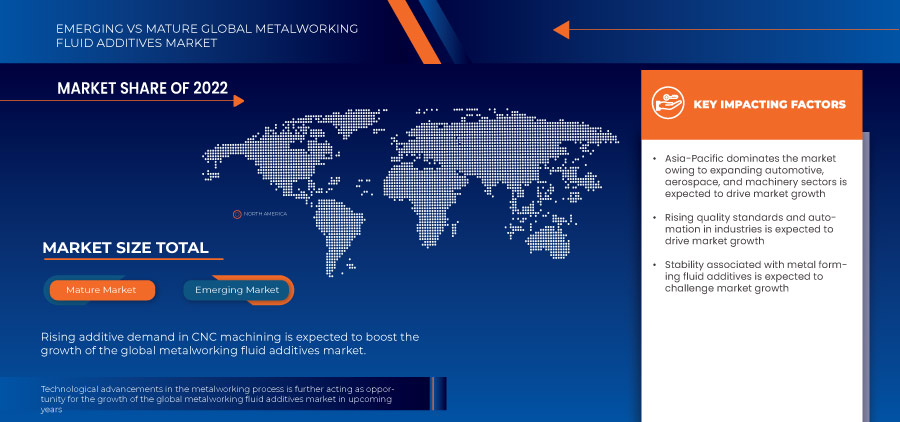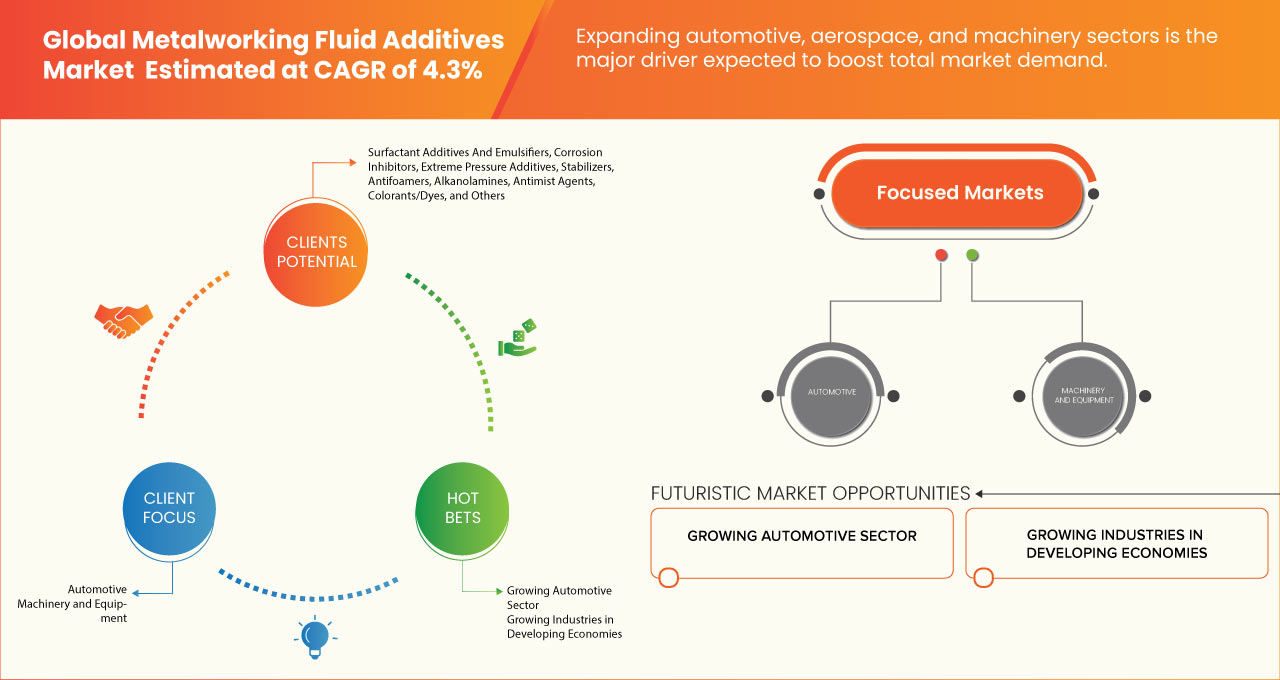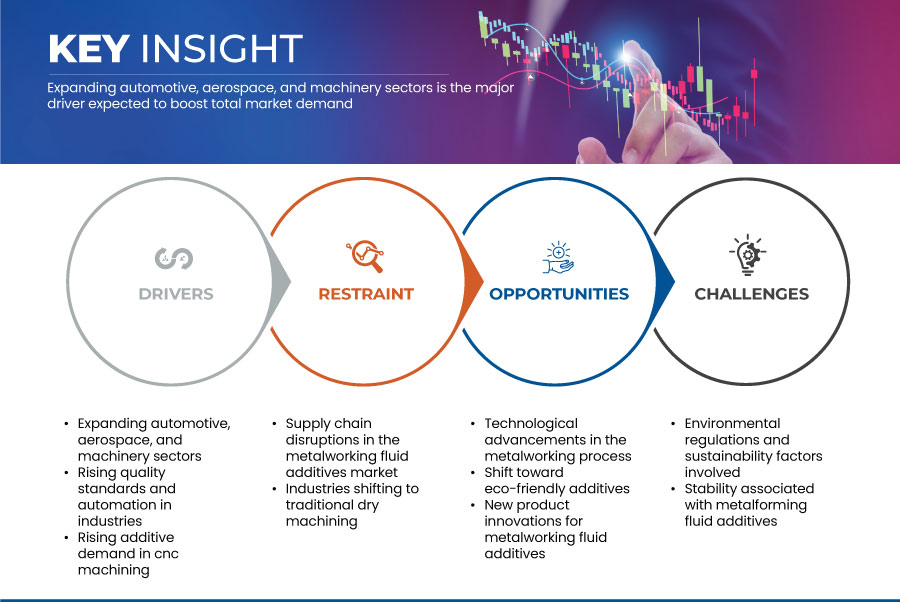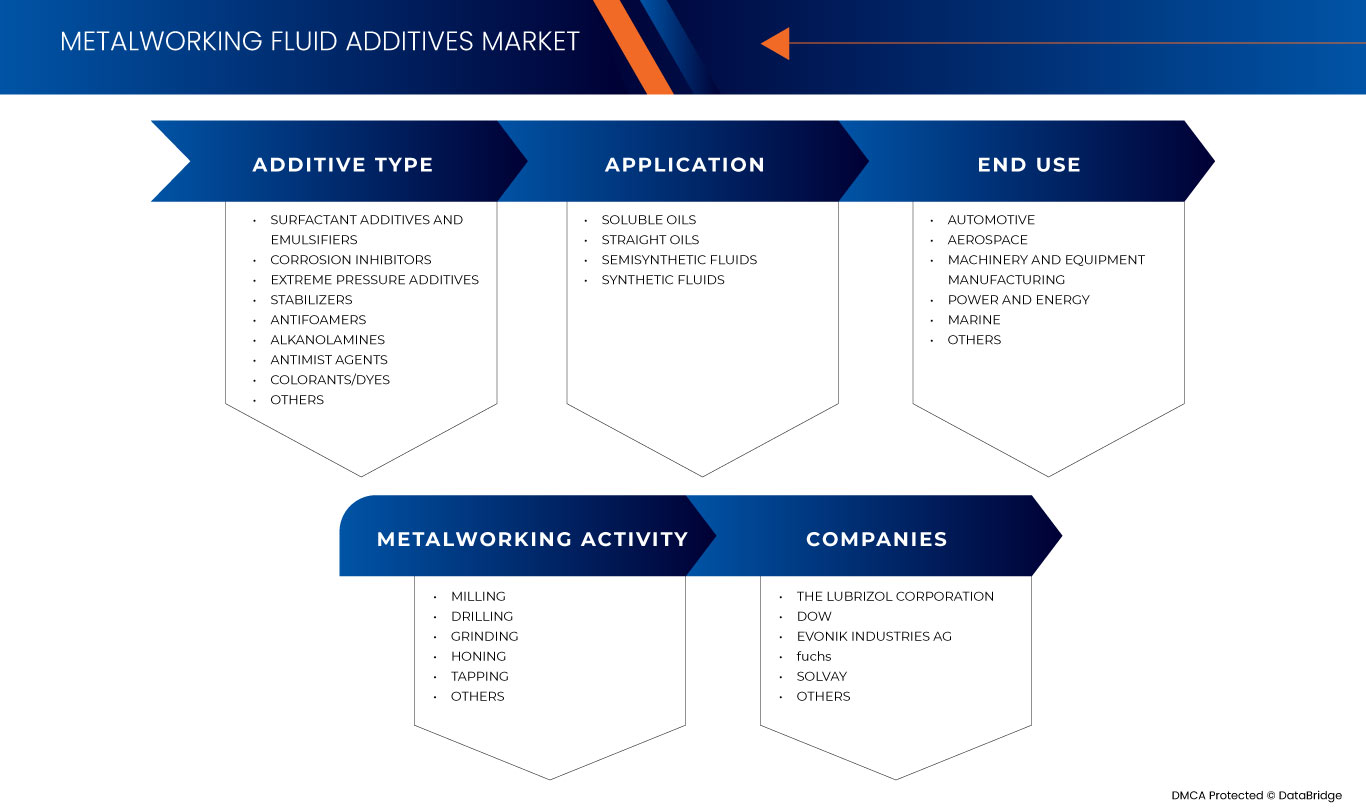Global Metalworking Fluid Additives Market, By Additive Type (Surfactant Additives and Emulsifiers, Corrosion Inhibitors, Extreme Pressure Additives, Stabilizers, Antifoamers, Alkanolamines, Antimist Agents, Colorants/Dyes, and Others), Application (Soluble Oils, Straight Oils, Semisynthetic Fluids, and Synthetic Fluids), Metalworking Activity (Milling, Drilling, Grinding, Honing, Tapping, and Others), End Use (Automotive, Aerospace, Machinery and Equipment Manufacturing, Power and Energy, Marine, and Others) - Industry Trends and Forecast to 2030.
Metalworking Fluid Additives Market Analysis and Insights
The expanding automotive, aerospace, and machinery sectors is the key factor fueling the market expansion. The escalation of quality standards and the increasing integration of automation within industries are instrumental in fostering opportunities for market growth.
The increasing adoption of dry machining across industries serves as a notable restraint affecting the market. Furthermore, fluctuations in raw material prices and availability represent a substantial challenge to market growth. The shift towards eco-friendly additives appears to be a rising opportunity that has the potential to lead to the market growth. Environmental regulations and sustainability factors have emerged as significant challenges impacting the growth trajectory of the market.
The global metalworking fluid additives market report provides details of market share, new developments, and product pipeline analysis, the impact of domestic and localized market players, analyzes opportunities in terms of emerging revenue pockets, changes in market regulations, product approvals, strategic decisions, product launches, geographic expansions, and technological innovations in the market. To understand the analysis and the market scenario contact us for an Analyst Brief, our team will help you create a revenue impact solution to achieve your desired goal.
The global metalworking fluid additives market is expected to gain market growth in the forecast period of 2023 to 2030. Data Bridge Market Research analyzes that the market is growing at a CAGR of 4.3% in the forecast period of 2023 to 2030 and is expected to reach USD 6,631,484.54 thousand by 2030. The rising additive demand in CNC machining are some of the driving factors expected to propel the market growth.
|
Report Metric |
Details |
|
Forecast Period |
2023 to 2030 |
|
Base Year |
2022 |
|
Historic Years |
2021 (Customizable to 2015-2020) |
|
Quantitative Units |
Revenue in USD Thousand |
|
Segments Covered |
Additive Type (Surfactant Additives and Emulsifiers, Corrosion Inhibitors, Extreme Pressure Additives, Stabilizers, Antifoamers, Alkanolamines, Antimist Agents, Colorants/Dyes, and Others), Application (Soluble Oils, Straight Oils, Semisynthetic Fluids, and Synthetic Fluids), Metalworking Activity (Milling, Drilling, Grinding, Honing, Tapping, and Others), End Use (Automotive, Aerospace, Machinery and Equipment Manufacturing, Power and Energy, Marine, and Others) |
|
Countries Covered |
U.S., Canada, Mexico, Germany, France, Spain, U.K., Italy, Russia, Belgium, Netherlands, Turkey, Sweden, Switzerland, Denmark, Norway, Finland, rest of Europe, China, India, Japan, South Korea, Singapore, Australia, Taiwan, Thailand, Indonesia, Malaysia, Hong Kong, New Zealand, Philippines, rest of Asia-Pacific, Brazil, Argentina, rest of South America, Saudi Arabia, Egypt, South Africa, Qatar, U.A.E., Israel, Oman, Kuwait, Bahrain, and rest of Middle East and Africa |
|
Market Players Covered |
The Lubrizol Corporation, Dow, Evonik Industries AG, FUCHS, Solvay, LANXESS, BP p.l.c., CLARIANT, Ingevity and its related entities, Ashland, Italmatch Chemicals S.p.A., Kao Corporation, Umicore, Colonial Chemical, Biosynthetic Technologies, DOVER CHEMICAL CORPORATION, Emery Oleochemicals, Pilot Chemical Corp., R.T. Vanderbilt Holding Company, Inc., and ZSCHIMMER & SCHWARZ, INC. |
Market Definition
Metalworking fluid additives (PFPE) is a low-molecular-weight fluorinated synthetic fluid. Metalworking fluid additives is non-toxic and non-flammable in its natural state. It is utilized in severe temperatures ranging from 80°C to 200°C. PFPE's molecular structure might be linear, branched, or a combination of both, depending on the application. Temperature resistance, lubricity, wear resistance, and fluid volatility are all provided by PFPE.
Global Metalworking Fluid Additives Market Dynamics
Drivers
- Expanding Automotive, Aerospace, and Machinery Sectors
In the global market, the demand for metalworking fluid additives is being driven by the rapid growth and expansion of important industry sectors including the automotive, aerospace, and machines. These industries represent modern manufacturing as a whole by continually pushing the boundaries of innovation and technical development.
The automobile sector, which is a pillar of economies all over the world, is constantly looking for ways to increase vehicle performance, safety, and efficiency. To produce precision components, this activity requires complex machining procedures. Metalworking fluid additives play a crucial role in guaranteeing smooth operations and enabling the production of high-quality automotive parts by offering lubrication, cooling, and chip removal.
- Rising Quality Standards and Automation in Industries
The escalation of quality standards and the increasing integration of automation within industries are instrumental in fostering opportunities for market growth. These two factors, in tandem, have initiated a paradigm shift in manufacturing practices and are reshaping the demand dynamics for metalworking fluid additives. Elevated quality standards have become paramount in modern manufacturing processes. Industries are under pressure to maintain precision, consistency, and adherence to stringent specifications to ensure product integrity and performance. Metalworking fluid additives play a pivotal role in achieving these goals. Additives that enhance lubrication, cooling, and anti-corrosion properties have become imperative for optimizing machining processes, improving tool longevity, and achieving superior product finishes. The demand for advanced metalworking fluid additives is set to rise as industries across sectors strive to meet or exceed these quality benchmarks, which results in boosting market growth.
Opportunities
- Technological Advancements in the Metalworking Process
Advancements in technology have emerged as a pivotal driver for the growth of the market. These technological developments have significantly influenced the formulation, application, and performance of metalworking fluid additives, creating a host of opportunities for market expansion.
One key area of technological advancement is the refinement of additive formulations. Manufacturers are leveraging cutting-edge research and innovation to develop additives that offer superior lubrication, corrosion protection, and cooling properties. Such precision-engineered additives enhance machining processes, improve tool life, and contribute to higher-quality finished products. This level of performance optimization creates a compelling value proposition for end-users, driving the demand for metalworking fluid additives. In addition, the advancements in nanotechnology have opened new avenues for enhancing the efficiency of metalworking fluid additives. Nanoparticles, due to their unique properties, can impart enhanced lubrication, heat transfer, and anti-wear characteristics to metalworking fluids.
- Shift Toward Eco-Friendly Additives
The market is undergoing a transformative shift driven by the increasing emphasis on environmental sustainability. As industries across the spectrum strive to reduce their ecological footprint, the adoption of eco-friendly additives within metalworking processes has emerged as a pivotal driver shaping the market's trajectory.
The traditional metalworking fluid additives landscape has long been dominated by formulations containing petroleum-based compounds and additives with potential health and environmental risks. However, the escalating awareness of these hazards, coupled with stringent regulations and growing consumer demands for sustainable products, has ushered in a paradigm shift towards more environmentally responsible alternatives.
Restraints/ Challenges
- Industries Shifting to Traditional Dry Machining
The increasing adoption of dry machining across industries serves as a notable restraint affecting the market. Dry machining, a technique where little to no coolant or lubricant is used during the machining process, has gained traction due to its potential for reduced costs, environmental benefits, and improved workplace conditions. This transition is not without its challenges, and its impact reverberates through the market.
One of the primary factors driving the shift to dry machining is the potential cost savings. Traditional metalworking fluids, along with the associated additives, require procurement, maintenance, and disposal efforts. Dry machining eliminates these costs, making it an attractive option for cost-conscious industries. In addition, dry machining reduces waste generation, streamlining waste disposal and contributing to a leaner manufacturing process.
- Fluctuation in Raw Material Prices
This factor, intricately linked to economic, geopolitical, and supply chain dynamics, directly impacts the production costs, pricing, and overall stability of the market. Metalworking fluid additives are formulated using a combination of key raw materials, including base oils, additive packages encompassing extreme pressure agents, anti-wear compounds, anti-foam agents, corrosion inhibitors, and specialty chemicals such as emulsifiers, biocides, and solvents.
These components collectively enhance the lubrication, cooling, corrosion resistance, and overall performance of metalworking fluids, crucially impacting machining processes. The formulation's composition is adapted to specific applications and machining requirements, making it a versatile solution for a range of metalworking operations. From this, we can infer that the raw materials, such as base oils, additives, and specialty chemicals, constitute a significant portion of the cost structure for metalworking fluid additives. The market's susceptibility to price fluctuations of these raw materials is a result of factors such as geopolitical tensions, shifts in supply-demand dynamics, and disruptions in global trade routes. Rapid changes in prices can lead to unpredictable cost escalations for manufacturers, exerting pressure on profit margins. Such volatility not only increases operational uncertainties but also hinders the ability to offer competitive pricing to end-users.
- Environmental Regulations and Sustainability Factors Involved
Environmental regulations and sustainability factors have emerged as significant challenges impacting the growth trajectory of the market. These factors stem from an increasing global focus on reducing the environmental footprint of industrial processes and aligning with sustainable practices.
This regulatory compliance challenge can impede market growth by raising the bar for entry and increasing operational complexities. In addition, the sustainability imperative is pushing industries to adopt greener practices, impacting the choice of metalworking fluid additives. End-users are now demanding eco-friendly additives that align with their sustainability goals. Biodegradability, reduced toxicity, and renewable sourcing are becoming key criteria in additive selection. This shift poses a challenge for manufacturers to reformulate their products, often necessitating substantial investments in research and development. Balancing performance with sustainability further adds to the complexity, potentially slowing down market expansion as manufacturers work to meet these new demands.
In conclusion, environmental regulations and sustainability factors present intricate challenges for the market. The evolving regulatory landscape, the need to align with sustainability goals, the demand for eco-friendly packaging, and the emergence of circular economy concepts collectively challenge manufacturers in terms of compliance, formulation, cost, and innovation. Successfully navigating these challenges will require strategic adaptation and a focus on environmentally responsible solutions, which are expected to challenge market growth.
Recent Developments
- In August 2023, Boecore selected Colorado Springs for expansion, driven by cybersecurity expertise. Growth incentives and the aerospace ecosystem reinforce Colorado's appeal amid considerations of Huntsville, Alabama, and Weber County, Utah
- In July 2023, Godrej Aerospace played a crucial role in India's space missions, supplying components for Chandrayaan-3. The company's expertise showcases its commitment to aerospace advancement and innovation, supporting both space exploration and commercial aviation industries
- In June 2023, According to BBC, OPEC controls almost 40% of the world’s supply of oil reserves. In addition to the former cutting down of production in April 2003 Saudi Arabia and other OPEC+ oil producers announced further oil output cuts of around 1.16 million barrels per day. OPEC can impact the global oil supply and, consequently, influence oil and gas prices all around the world which will ultimately affect the cost of the products which utilize crude oil as their raw material
- In July 2023, according to an article published by LNG, The European Chemicals Agency is proposing a seven-year transition period for medium-chain chlorinated paraffin and other substances containing chloroalkanes with C14 to C17 range carbon chain lengths. The restriction aims to assess potential risks to human health or the environment from the manufacture, use, or trade of these substances. Medium-chain chlorinated paraffin is used in metalworking fluids as an extreme-pressure agent for difficult operations, protecting tools and components from friction, wear, and overheating at high speeds and pressures
Global Metalworking Fluid Additives Market Scope
The global metalworking fluid additives market is segmented into four notable segments based on additive type, application, metalworking activity, and end use. The growth among segments helps you analyze niche pockets of growth and strategies to approach the market and determine your core application areas and the difference in your target markets.
Additive Type
- Surfactant Additives and Emulsifiers
- Corrosion Inhibitors
- Extreme Pressure Additives
- Stabilizers
- Antifoamers
- Alkanolamines
- Antimist Agents
- Colorants/dyes
- Others
On the basis of additive type, the market is segmented into surfactant additives and emulsifiers, corrosion inhibitors, extreme pressure additives, stabilizers, antifoamers, alkanolamines, antimist agents, colorants/dyes, and others.
Application
- Soluble Oils
- Straight Oils
- Semisynthetic Fluids
- Synthetic Fluids
On the basis of application, the market is segmented into soluble oils, straight oils, semisynthetic fluids, and synthetic fluids.
Metalworking Activity
- Milling
- Drilling
- Grinding
- Honing
- Tapping
- Others
On the basis of metalworking activity, the market is segmented into milling, drilling, grinding, honing, tapping, and others.
End Use
- Automotive
- Aerospace
- Machinery and Equipment Manufacturing
- Power and Energy
- Marine
- Others
On the basis of end use, the market is segmented into automotive, aerospace, machinery and equipment manufacturing, power and energy, marine, and others.
Global Metalworking Fluid Additives Market Regional Analysis
The global metalworking fluid additives market is analyzed and market size information is provided by of additive type, application, metalworking activity, and end use as referenced above.
The countries covered in this market report are U.S., Canada, Mexico, Germany, France, Spain, U.K., Italy, Russia, Belgium, Netherlands, Turkey, Sweden, Switzerland, Denmark, Norway, Finland, rest of Europe, China, India, Japan, South Korea, Singapore, Australia, Taiwan, Thailand, Indonesia, Malaysia, Hong Kong, New Zealand, Philippines, rest of Asia-Pacific, Brazil, Argentina, rest of South America, Saudi Arabia, Egypt, South Africa, Qatar, U.A.E., Israel, Oman, Kuwait, Bahrain, and rest of Middle East and Africa
Asia-Pacific region is expected to dominate the market due to the rapid industrialization and strong demand for manufacturing in the region. China is the fastest growing country in this region has strong industrial base, robust manufacturing sector, and high demand for metalworking fluids. U.S. in North America is the fastest growing country in this region due to its rapidly growing manufacturing industry, expanding automotive sector, and increasing metalworking activities. Germany in Europe dominating this market due its well-established manufacturing infrastructure, advanced technology adoption.
The country section of the report also provides individual market-impacting factors and changes in regulation in the market domestically that impact the current and future trends of the market. Data points such as new sales, replacement sales, country demographics, regulatory acts, and import-export tariffs are some of the major pointers used to forecast the market scenario for individual countries. Also, the presence and availability of global brands and their challenges faced due to large or scarce competition from local and domestic brands, and the impact of sales channels are considered while providing forecast analysis of the country data.
Competitive Landscape and the Global Metalworking Fluid Additives Market Share Analysis
The global metalworking fluid additives market competitive landscape provides details of competitors. Details included are company overview, company financials, revenue generated, market potential, investment in research and development, new market initiatives, global presence, production sites and facilities, company strengths and weaknesses, product launch, clinical trials pipelines, brand analysis, product approvals, patents, product width and breath, application dominance, technology lifeline curve. The above data points provided are only related to the company’s focus related to the market.
The major players covered in this report are The Lubrizol Corporation, Dow, Evonik Industries AG, FUCHS, Solvay, LANXESS, BP p.l.c., CLARIANT, Ingevity and its related entities, Ashland, Italmatch Chemicals S.p.A., Kao Corporation, Umicore, Colonial Chemical, Biosynthetic Technologies, DOVER CHEMICAL CORPORATION, Emery Oleochemicals, Pilot Chemical Corp., R.T. Vanderbilt Holding Company, Inc., and ZSCHIMMER & SCHWARZ, INC., among others.
SKU-
Get online access to the report on the World's First Market Intelligence Cloud
- Interactive Data Analysis Dashboard
- Company Analysis Dashboard for high growth potential opportunities
- Research Analyst Access for customization & queries
- Competitor Analysis with Interactive dashboard
- Latest News, Updates & Trend analysis
- Harness the Power of Benchmark Analysis for Comprehensive Competitor Tracking
Table of Content
1 INTRODUCTION
1.1 OBJECTIVES OF THE STUDY
1.2 MARKET DEFINITION
1.3 OVERVIEW OF THE GLOBAL METALWORKING FLUID ADDITIVES MARKET
1.4 LIMITATIONS
1.5 MARKETS COVERED
2 MARKET SEGMENTATION
2.1 MARKETS COVERED
2.2 GEOGRAPHICAL SCOPE
2.3 YEARS CONSIDERED FOR THE STUDY
2.4 CURRENCY AND PRICING
2.5 DBMR TRIPOD DATA VALIDATION MODEL
2.6 MULTIVARIATE MODELLING
2.7 PRIMARY INTERVIEWS WITH KEY OPINION LEADERS
2.8 DBMR MARKET POSITION GRID
2.9 MARKET END USE COVERAGE GRID
2.1 SECONDARY SOURCES
2.11 ASSUMPTIONS
3 EXECUTIVE SUMMARY
4 PREMIUM INSIGHTS
5 MARKET OVERVIEW
5.1 DRIVERS
5.1.1 EXPANDING AUTOMOTIVE, AEROSPACE, AND MACHINERY SECTORS
5.1.2 RISING QUALITY STANDARDS AND AUTOMATION IN INDUSTRIES
5.1.3 RISING ADDITIVE DEMAND IN CNC MACHINING
5.2 RESTRAINTS
5.2.1 SUPPLY CHAIN DISRUPTIONS IN THE METALWORKING FLUID ADDITIVES MARKET
5.2.2 INDUSTRIES SHIFTING TO TRADITIONAL DRY MACHINING
5.2.3 FLUCTUATION IN RAW MATERIAL PRICES
5.3 OPPORTUNITIES
5.3.1 TECHNOLOGICAL ADVANCEMENTS IN THE METALWORKING PROCESS
5.3.2 SHIFT TOWARD ECO-FRIENDLY ADDITIVES
5.3.3 NEW PRODUCT INNOVATIONS FOR METALWORKING FLUID ADDITIVES
5.4 CHALLENGES
5.4.1 ENVIRONMENTAL REGULATIONS AND SUSTAINABILITY FACTORS INVOLVED
5.4.2 STABILITY ASSOCIATED WITH METALFORMING FLUID ADDITIVES
6 GEOGRAPHICAL ANALYSIS
6.1 GLOBAL
6.2 EUROPE
6.3 ASIA PACIFIC
6.4 NORTH AMERICA
6.5 MIDDLE EAST AND AFRICA
6.6 SOUTH AMERICA
7 GLOBAL METALWORKING FLUID ADDITIVES MARKET: COMPANY LANDSCAPE
7.1 COMPANY SHARE ANALYSIS: GLOBAL
7.2 COMPANY SHARE ANALYSIS: EUROPE
7.3 COMPANY SHARE ANALYSIS: ASIA-PACIFIC
7.4 COMPANY SHARE ANALYSIS: NORTH AMERICA
7.5 PARTNERSHIPS & CONTRACTS
7.6 EVENT
7.7 AWARD
8 SWOT ANALYSIS
9 COMPANY PROFILES
9.1 THE LUBRIZOL CORPORATION
9.1.1 COMPANY SNAPSHOT
9.1.2 COMPANY SHARE ANALYSIS
9.1.3 PRODUCT PORTFOLIO
9.1.4 RECENT DEVELOPMENT
9.2 EVONIK INDUSTRIES AG
9.2.1 COMPANY SNAPSHOT
9.2.2 REVENUE ANALYSIS
9.2.3 COMPANY SHARE ANALYSIS
9.2.4 PRODUCT PORTFOLIO
9.2.5 RECENT DEVELOPMENT
9.3 DOW
9.3.1 COMPANY SNAPSHOT
9.3.2 REVENUE ANALYSIS
9.3.3 COMPANY SHARE ANALYSIS
9.3.4 PRODUCT PORTFOLIO
9.3.5 RECENT DEVELOPMENT
9.4 FUCHS
9.4.1 COMPANY SNAPSHOT
9.4.2 REVENUE ANALYSIS
9.4.3 COMPANY SHARE ANALYSIS
9.4.4 PRODUCT PORTFOLIO
9.4.5 RECENT DEVELOPMENT
9.5 SOLVAY
9.5.1 COMPANY SNAPSHOT
9.5.2 REVENUE ANALYSIS
9.5.3 COMPANY SHARE ANALYSIS
9.5.4 PRODUCT PORTFOLIO
9.5.5 RECENT DEVELOPMENT
9.6 ASHLAND
9.6.1 COMPANY SNAPSHOT
9.6.2 REVENUE ANALYSIS
9.6.3 PRODUCT PORTFOLIO
9.6.4 RECENT DEVELOPMENT
9.7 BIOSYNTHETIC TECHNOLOGIES
9.7.1 COMPANY SNAPSHOT
9.7.2 PRODUCT PORTFOLIO
9.7.3 RECENT DEVELOPMENTS
9.8 BP P.L.C.
9.8.1 COMPANY SNAPSHOT
9.8.2 REVENUE ANALYSIS
9.8.3 PRODUCT PORTFOLIO
9.8.4 RECENT DEVELOPMENT
9.9 CLARIANT
9.9.1 COMPANY SNAPSHOT
9.9.2 REVENUE ANALYSIS
9.9.3 PRODUCT PORTFOLIO
9.9.4 RECENT DEVELOPMENTS
9.1 COLONIAL CHEMICAL
9.10.1 COMPANY SNAPSHOT
9.10.2 PRODUCT PORTFOLIO
9.10.3 RECENT DEVELOPMENT
9.11 DOVER CHEMICAL CORPORATION
9.11.1 COMPANY SNAPSHOT
9.11.2 PRODUCT PORTFOLIO
9.11.3 RECENT DEVELOPMENT
9.12 EMERY OLEOCHEMICALS
9.12.1 COMPANY SNAPSHOT
9.12.2 PRODUCT PORTFOLIO
9.12.3 RECENT DEVELOPMENT
9.13 INGEVITY AND ITS RELATED ENTITIES
9.13.1 COMPANY SNAPSHOT
9.13.2 REVENUE ANALYSIS
9.13.3 PRODUCT PORTFOLIO
9.13.4 RECENT DEVELOPMENT
9.14 ITALMATCH CHEMICALS S.P.A
9.14.1 COMPANY SNAPSHOT
9.14.2 REVENUE ANALYSIS
9.14.3 PRODUCT PORTFOLIO
9.14.4 RECENT DEVELOPMENT
9.15 KAO CORPORATION
9.15.1 COMPANY SNAPSHOT
9.15.2 REVENUE ANALYSIS
9.15.3 PRODUCT PORTFOLIO
9.15.4 RECENT DEVELOPMENT
9.16 LANXESS
9.16.1 COMPANY SNAPSHOT
9.16.2 REVENUE ANALYSIS
9.16.3 PRODUCT PORTFOLIO
9.16.4 RECENT DEVELOPMENT
9.17 PILOT CHEMICAL
9.17.1 COMPANY SNAPSHOT
9.17.2 PRODUCT PORTFOLIO
9.17.3 RECENT DEVELOPMENT
9.18 R.T. VANDERBILT HOLDING COMPANY, INC.
9.18.1 COMPANY SNAPSHOT
9.18.2 PRODUCT PORTFOLIO
9.18.3 RECENT DEVELOPMENT
9.19 UMICORE
9.19.1 COMPANY SNAPSHOT
9.19.2 REVENUE ANALYSIS
9.19.3 PRODUCT PORTFOLIO
9.19.4 RECENT DEVELOPMENT
9.2 ZSCHIMM ER & SCHWARZ, INC.
9.20.1 COMPANY SNAPSHOT
9.20.2 PRODUCT PORTFOLIO
9.20.3 RECENT DEVELOPMENT
10 QUESTIONNAIRE
11 RELATED REPORTS
List of Figure
FIGURE 1 GLOBAL METALWORKING FLUID ADDITIVES MARKET: SEGMENTATION
FIGURE 2 GLOBAL METALWORKING FLUID ADDITIVES MARKET: DATA TRIANGULATION
FIGURE 3 GLOBAL METALWORKING FLUID ADDITIVES MARKET: DROC ANALYSIS
FIGURE 4 GLOBAL METALWORKING FLUID ADDITIVES MARKET: GLOBAL VS REGIONAL MARKET ANALYSIS
FIGURE 5 GLOBAL METALWORKING FLUID ADDITIVES MARKET: COMPANY RESEARCH ANALYSIS
FIGURE 6 GLOBAL METALWORKING FLUID ADDITIVES MARKET: INTERVIEW DEMOGRAPHICS
FIGURE 7 GLOBAL METALWORKING FLUID ADDITIVES MARKET: DBMR MARKET POSITION GRID
FIGURE 8 GLOBAL METALWORKING FLUID ADDITIVES MARKET: MARKET END USE COVERAGE GRID
FIGURE 9 GLOBAL METALWORKING FLUID ADDITIVES MARKET: SEGMENTATION
FIGURE 10 STRONG SPENDING TOWARDS PHARMA INDUSTRY IS DRIVING THE GROWTH OF THE GLOBAL METALWORKING FLUID ADDITIVES MARKET IN THE FORECAST PERIOD
FIGURE 11 THE SURFACTANT ADDITIVES AND EMULSIFIERS SEGMENT IS EXPECTED TO ACCOUNT FOR THE LARGEST SHARE OF THE GLOBAL METALWORKING FLUID ADDITIVES MARKET IN 2023 AND 2030
FIGURE 12 DRIVERS, RESTRAINTS, OPPORTUNITIES, AND CHALLENGES OF THE GLOBAL METALWORKING FLUID ADDITIVES MARKET
FIGURE 13 GLOBAL METALWORKING FLUID ADDITIVES MARKET: SNAPSHOT (2022)
FIGURE 14 EUROPA METALWORKING FLUID ADDITIVES MARKET: SNAPSHOT (2022)
FIGURE 15 ASIA PACIFIC METALWORKING FLUID ADDITIVES MARKET: SNAPSHOT (2022)
FIGURE 16 NORTH AMERICA METALWORKING FLUID ADDITIVES MARKET: SNAPSHOT (2022)
FIGURE 17 MIDDLE EAST AND AFRICA METALWORKING FLUID ADDITIVES MARKET: SNAPSHOT (2022)
FIGURE 18 SOUTH AMERICA METALWORKING FLUID ADDITIVES MARKET: SNAPSHOT (2022)
FIGURE 19 GLOBAL METALWORKING FLUID ADDITIVES MARKET: COMPANY SHARE 2022 (%)
FIGURE 20 EUROPE METALWORKING FLUID ADDITIVES MARKET: COMPANY SHARE 2022 (%)
FIGURE 21 ASIA-PACIFC METALWORKING FLUID ADDITIVES MARKET: COMPANY SHARE 2022 (%)
FIGURE 22 NORTH AMERICA METALWORKING FLUID ADDITIVES MARKET: COMPANY SHARE 2022 (%)

Global Metalworking Fluid Additives Market, Supply Chain Analysis and Ecosystem Framework
To support market growth and help clients navigate the impact of geopolitical shifts, DBMR has integrated in-depth supply chain analysis into its Global Metalworking Fluid Additives Market research reports. This addition empowers clients to respond effectively to global changes affecting their industries. The supply chain analysis section includes detailed insights such as Global Metalworking Fluid Additives Market consumption and production by country, price trend analysis, the impact of tariffs and geopolitical developments, and import and export trends by country and HSN code. It also highlights major suppliers with data on production capacity and company profiles, as well as key importers and exporters. In addition to research, DBMR offers specialized supply chain consulting services backed by over a decade of experience, providing solutions like supplier discovery, supplier risk assessment, price trend analysis, impact evaluation of inflation and trade route changes, and comprehensive market trend analysis.
Research Methodology
Data collection and base year analysis are done using data collection modules with large sample sizes. The stage includes obtaining market information or related data through various sources and strategies. It includes examining and planning all the data acquired from the past in advance. It likewise envelops the examination of information inconsistencies seen across different information sources. The market data is analysed and estimated using market statistical and coherent models. Also, market share analysis and key trend analysis are the major success factors in the market report. To know more, please request an analyst call or drop down your inquiry.
The key research methodology used by DBMR research team is data triangulation which involves data mining, analysis of the impact of data variables on the market and primary (industry expert) validation. Data models include Vendor Positioning Grid, Market Time Line Analysis, Market Overview and Guide, Company Positioning Grid, Patent Analysis, Pricing Analysis, Company Market Share Analysis, Standards of Measurement, Global versus Regional and Vendor Share Analysis. To know more about the research methodology, drop in an inquiry to speak to our industry experts.
Customization Available
Data Bridge Market Research is a leader in advanced formative research. We take pride in servicing our existing and new customers with data and analysis that match and suits their goal. The report can be customized to include price trend analysis of target brands understanding the market for additional countries (ask for the list of countries), clinical trial results data, literature review, refurbished market and product base analysis. Market analysis of target competitors can be analyzed from technology-based analysis to market portfolio strategies. We can add as many competitors that you require data about in the format and data style you are looking for. Our team of analysts can also provide you data in crude raw excel files pivot tables (Fact book) or can assist you in creating presentations from the data sets available in the report.



















